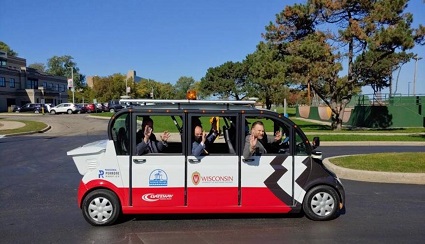Multimodal / Non-Drivers
The Wisconsin Department of Transportation is committed to safe multi-modal options for all users of the transportation system and engages external stakeholders to discuss transportation mobility, safety and access for Wisconsin’s non-driving populations. Non-driving populations can include aging adults, students, low-income individuals, those with physical, mental or intellectual/developmental disabilities, and those who prefer not to drive. Of the Wisconsin population 31% do not have a driver’s license.
Non-drivers face daily challenges to get to where they want to go. With CAV technology the transportation system can be enhanced to provide novel solutions for those users so they have the same quick, efficient, and flexible access to work, hospitality, and businesses as others enjoy.
CAV technology has the potential to provide 24hr on-demand service in areas where it is currently uneconomical. Small capacity, low speed shuttles may be able to extend service areas. Automated vehicles are being tested with fixed and flexible routes that can provide wide coverage to low volume areas linking riders to the end of high volume bus or rail transit routes.
Equity in transportation
All users should have equitable access to transportation and those destinations that improve a family’s quality of life. Many employment options, public services, hospitality and others are not serviced well by existing transit options.
CAV technology for transit that can positively impact all users are being investigated. Potential benefits include things like:
- Employment options access

- Hospitality access
- Business access
- Reduced fuel consumption (and associated pollution)
- Reduction of congestions reduces logistic costs
- Safety
- Frequency of service
- Route flexibility
- Off-hour transit options and on-demand service equalize access for non-drivers
- Pedestrian safety improved with 360 degree AV sensors
The department sponsored Wisconsin Automated Vehicle External (WAVE) Advisory Committee
committee organized an advisory meeting in September of 2021. This discussion centered around equity in transportation and CAVs, and was designed to solicit guidance from transportation stakeholders outside the department. Expert panel discussions covered research on equity, urban planning, transit challenges in Wisconsin and equity efforts being pursued nationally.
Racine Badger
 The Racine automated vehicle shuttle, known as the Badger, represents the first municipal AV deployment in Wisconsin. The Badger is an automated EV. The vehicle is a partnership between the City of Racine, Gateway Technical College and the
University of Wisconsin-Madison’s Traffic Operations and Safety Laboratory (TOPS Lab).
The Racine automated vehicle shuttle, known as the Badger, represents the first municipal AV deployment in Wisconsin. The Badger is an automated EV. The vehicle is a partnership between the City of Racine, Gateway Technical College and the
University of Wisconsin-Madison’s Traffic Operations and Safety Laboratory (TOPS Lab).
The Badger has Level 4 automation technology and is currently being tested on a short route around the Gateway Technical College campus, with a safety driver, to provide short, low-speed trips in an urban setting for research and public exposure.
The Badger research is intended to learn more about automated vehicle sensors, how AV transit vehicles might augment transit systems, and public reaction to this new technology.
Transit-Related Resources
WisDOT Transit assistance programs
Wisconsin Department of Transportation Transit assistance programs (wisconsindot.gov)
WAVE – Wisconsin Automated Vehicle External (WAVE) Advisory Committee
Wisconsin Department of Transportation Wisconsin Automated Vehicle External Advisory Committee (wisconsindot.gov)